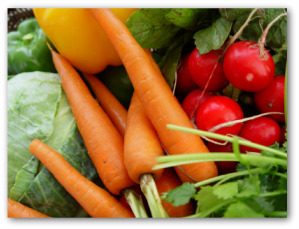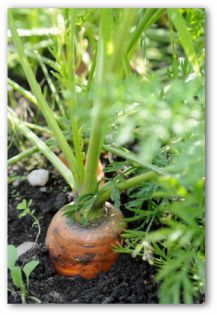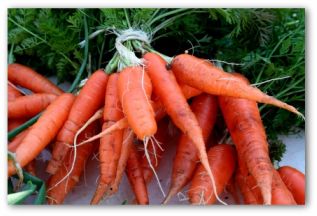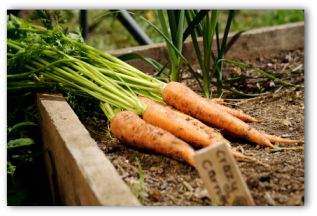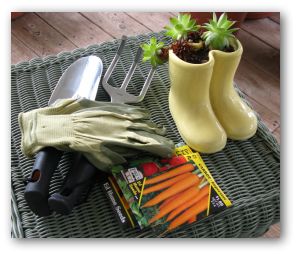Planting Carrots in
Your Backyard Garden
Here are a few great tips for planting carrots in a backyard vegetable garden!
Learn easy ways to plant, water, and harvest growing carrots.
Soil preparation is key when sowing carrots in your home vegetable garden.
Design Your Own Vegetable Garden Layout Using our Free "Vegetable Garden Planner" Software!
- It is important that you grow your carrot seeds in a well-drained, loose, loamy, sandy soil.
- A few weeks before planting your carrots, make sure the soil is a light, clod free, crumbly mixture.
- It's easy to grow fresh, sweet, organic carrots in your own backyard!
Before Planting Carrots
Add plenty of organic materials to the garden soil before planting carrot seeds.
Seeds will germinate in temperatures as low as 40 degrees, but grow better in temperatures reaching nearer 50 degrees.
Download Free Garden Planning Worksheets, Garden Diary, Zone Chart, Or Planting Guide
Sowing Carrot Seeds in the Garden
- Sow carrot seed about one inch apart.
- Seedlings should appear in a few weeks.
- Thin plants when they reach about an inch tall.
- Plant rows at three week intervals if you desire a bounty of carrots to last through the summer.
An example of vegetable succession planning for Hardiness Zone 7, plant carrot in March to be followed by beets, then next in line, pepper.
Soil Preparation for Growing Organic Carrots
Carrots require enriched soil that is moist, fertile, and drains well.
To prepare the soil for growing organic carrots, work plenty of organic matter into the seedbed before sowing carrots.
Add compost to the soil a month prior to planting and again two weeks after the seeds are planted.
Avoid using green manure.
When preparing the bed make certain you remove all large debris such as sticks and stones that could block the vegetable's growth down below.
Turn the garden bed soil and rake through it several times.
Which Carrot Varieties are Best?
There are many varieties of carrots available but choose a type suitable for growing in your area.
With
only a glance through seed catalogs, you will find carrot varieties
ranging from the usual orange color to purple, white, and yellow colored
carrots!
To name just a sampling:
Short varieties: Little Finger and Short ‘n Sweet.
Long varieties: King Midas and Goliath. Medium varieties: Tendersweet and Presto.
When to Sow Carrot Seeds
Sowing the seeds at the right growing temperatures is an important step in planting carrots successfully.
Seeds sown too early before the soil warms can cause the carrots to seed sooner than desired.
On the other hand, planting carrots when the ground is continually warm results in poor production.
Follow the recommended cultivation instructions for planting carrots according to the variety.
Watering, Mulching,and Thinning Carrots
Growing carrots require moist soil, especially when sowing the seeds and as the first seedlings appear.
- The key is keeping the soil sufficiently moist without causing it to be water-logged, which causes root hairs to develop on the vegetables.
- After carrot plants are established, usually 1" of water per week is enough.
- Mulching helps the soil retain moisture and prevents discoloration at the top of the carrot root.
- Thin out the seedlings after a few weeks to the healthiest plants.
- After a couple more weeks, thin the plants to their final spacing of three inches apart.
- This is the perfect time to enjoy eating some fresh baby carrots from the garden!
Best Companion Plants for Growing Carrots
Vegetable companions for planting carrots are tomatoes, onions, leeks, peas, and chives.
Harvesting Carrots
- Depending on the variety, the carrots should be ready for harvest in 50-80 days.
- It is time to harvest when the foliage on the carrot top noticeably begins to dry out.
- True root vegetables such as the carrot are ideal plants; the vegetables are content to remain in the ground until the gardener is ripe for the picking!
- It is fine to leave your carrots in the ground through frosty fall weather.
- However, dig them before the ground begins to freeze for best results.
Carrots are tasty cooked in stews, soups, or alone with sugar added. Yum!
Planting carrots, which are rich in vitamin A, are a healthy addition to the vegetable garden.
Pull the carrots out of the ground and enjoy! That's all folks!
"Carrots are divine, you get a dozen for a dime, it's magic"! ~ Bugs Bunny
You Might Also like to Read:
Growing Carrots